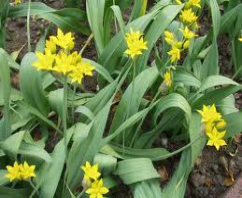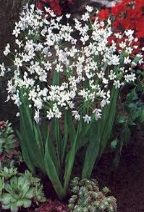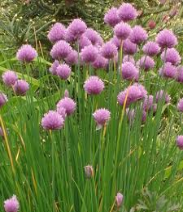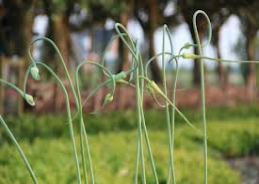Allium species
 Allium moly bulbiferum
Allium moly bulbiferum
The bulbs can be eaten raw or cooked. A pleasant mild garlic flavour, when sliced it makes a very nice addition to salads and can also be used as a flavouring in cooked foods. The bulbs are about 25mm in diameter.
The leaves are also edible, raw or cooked.
The flowers can be eaten raw. The yellow flowers make an attractive garnish on salads and have a pleasant onion flavour.
Although no specific mention of medicinal uses has been seen for this species, members of this genus are in general very healthy additions to the diet. They contain sulphur compounds (which give them their onion flavour) and when added to the diet on a regular basis they help reduce blood cholesterol levels, act as a tonic to the digestive system and also tonify the circulatory system.
 Daffodil garlic, Allium neapolitanum
Daffodil garlic, Allium neapolitanum
The bulb can be eaten raw or cooked. Rather small but a very nice mild garlic flavour. Sliced up, they make a delicious addition to salads and can also be used as a vegetable or as a flavouring in cooked foods.They are harvested in mid summer once the plant dies down and will store for 6 months or more. The bulbs are 10 - 20mm in diameter.
The leaves are edible raw or cooked. Delicious in salads, they start off being sweet and then develop a fairly strong garlic-like flavour, they are liked by most people who try them. The leaves are available from late autumn until early spring and are greatly appreciated at this time of year.
Flowers are used raw or cooked. Excellent in salads, making them look attractive as well as adding a strong onion flavour.
 Chives, allium schoenoprasum
Chives, allium schoenoprasum
As above.
A well known herb.
Everlasting onion, allium cepa 'perutile'
The bulb is used raw or cooked. A very versatile food, the bulb can be 10 cm or more in diameter and is widely used in most countries of the world.
Eaten raw, it can be sliced up and used in salads, sandwich fillings etc, it can be baked or boiled as a vegetable in its own right and is also commonly used as a flavouring in soups, stews and many other cooked dishes.
Some cultivars have been selected for their smaller and often hotter bulbs and these are used for making pickles.
The leaves are eaten raw or cooked. There are some cultivars, the spring onions, that have been selected for their leaves and are used in salads whilst still young and actively growing - the bulb is much smaller than in other cultivars and is usually eaten with the leaves. By successional sowing, they can be available at any time of the year.
The flowers are edible raw. Used as a garnish on salads. The flowers are somewhat dry and are less pleasant than many other species.
The seeds are sprouted and eaten. They have a delicious onion flavour.
Medicinal uses as above alliums.
 Serpent garlic, allium sativum ophioscorodon
Serpent garlic, allium sativum ophioscorodon
The bulb can be used raw or cooked. Widely used, especially in southern Europe, as a flavouring in a wide range of foods, both raw and cooked. Garlic is a wonderfully nutritious and health giving addition to the diet, but it has a very strong flavour and so is mainly used in very small quantities as a flavouring in salads and cooked foods. The bulbs can be up to 6 cm in diameter.
The plant forms bulbils which can be used raw or cooked. An excellent strong garlic flavour, though they are rather small and therefore fiddly to peel.
The leaves are edible raw or cooked. Chopped and used in salads, they are rather milder than the bulbs. The Chinese often cultivate garlic especially for the leaves, these can be produced in the middle of winter in mild winters.
The flowering stems are used as a flavouring and are sometimes sold in Chinese shops.
The sprouted seed is added to salads.
Garlic has a very long folk history of use in a wide range of ailments, particularly ailments such as ringworm, Candida and vaginitis where its fungicidal, antiseptic, tonic and parasiticidal properties have proved of benefit.
The plant produces inhibitory effects on gram-negative germs of the typhoid-paratyphoid-enteritis group, indeed it possesses outstanding germicidal properties and can keep amoebic dysentery at bay. It is also said to have anticancer activity.
It has also been shown that garlic aids detoxification of chronic lead poisoning.
Daily use of garlic in the diet has been shown to have a very beneficial effect on the body, especially the blood system and the heart.
